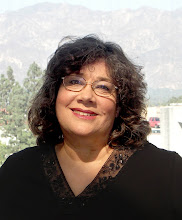
Jean Spitzer wins this week's fabulous prize with her answer "Raymond? And the Red Car line is being removed?"
In the photo above, taken Oct. 28, 1940, Pacific Electric Railway tracks have been removed on Raymond Avenue just north of Walnut Street (looking north) and the road is being prepared for all-new paving -- without rail tracks -- to accommodate automobiles.
I cropped the photo for Tuesday's post. Here's the full image:

The Pacific Electric Railway was also known as the Red Car System. In their heyday, two lines to and from Pasadena and Santa Monica -- the Short Line and the Oak Knoll Line -- boosted tourism tremendously with the promise of taking passengers "from the mountains to the sea" in one relatively quick trip (with stops along the way, including downtown Los Angeles).
Here's an undated, color-tinted photo of a Red Car on the Oak Knoll line:

It all began with the all-electric Pasadena & Pacific Railroad -- the P&P as it was more commonly known -- in 1885. The P&P connected Pasadena and downtown Los Angeles.
Here's a P&P electric trolley at Colorado Street and Raymond Avenue in the late 1800s:

Henry Huntington, who had recently incorporated his new Pacific Electric Railway, purchased the P&P in 1901. As the nephew of tycoon Collis P. Huntington, railroading was in Henry's blood.
He was the subject of this drawing illustrating his impact on the area's growth.

He maintained control of Pacific Electric Railway (PE) until 1911, when he sold it to Southern Pacific.
Many people thought the horseless carriage was a passing fad -- why spend a then-whopping $850 for such a thing? -- and few dreamed of actually owning one. Besides, there were no highways yet and few paved roads on which to drive automobiles.
So the PE's Red Cars served as the primary mode of transportation for getting to work, shopping, going to social engagements and other necessary excursions.
Here's a gathering of conductors in Pacific Electric's street car barn in Pasadena:

The street car barn was also featured in a photo on this post:
PE's most popular line for tourists was the Mount Lowe Railway, which Henry Huntington purchased in 1902. It closed in 1938 after a fire destroyed the Alpine Tavern and a bad rainstorm seriously damaged the tracks.

When Henry Ford began mass-producing automobiles in Detroit at an affordable price -- $270 by the 1920s -- the popularity of the Red Cars began to wane.
PE found it increasingly difficult to earn profits from passenger service for a number of reasons, including the cost of electricity, the Great Depression and the growing popularity of automobiles, so they greatly reduced the number of Red Cars, introduced more profitable bus lines and began using their rails for hauling freight.

Here's a photo of rails being removed on Raymond Avenue at Dayton Street, also in October 1940.

And here's an example of road-paving in Pasadena to make way for autos: city Street Department workers grading Hill Avenue between Washington Boulevard and the northern city limits in 1938.

History's a funny thing, isn't it? Passenger rail has returned to Pasadena.
So on we go.
Many thanks to Pasadena Public Library, Pasadena Museum of History, the Volkmer Collection and Jim Walker for use of the photos.

9 comments:
The rails have returned, now if only we could bring back the California Cycleway...
Hooray for Jean.
Way to go, Jean. I'm always clueless when I see these photos.
Thanks for another fascinating history lesson, Ann.
Yay Jean! Ann, you posted some wonderful old photos. that stack of red line engines...
I won! Demonstrates the wisdom of keeping it short and taking wild guesses. Seriously, it makes me sad about the public transportation that was, and is no longer. The Gold Line is good, and there are other lines to connect with through Union Station. But the Red Cars were beloved. Anyone old enough to have experienced the Red Cars--that I've spoken to--speaks fondly and nostalgically of them.
I love these posts, Ann. The photos are great. The one of the orderly pile of rail cars is amazing.
Way to go, Jean.
My grand uncle a red car conductor. I wonder if there is a way to find out what line he drove.
Grover Van Der Zee
I could spend the whole evening looking at historical photos, they're so fascinating. There's an equally fascinating documentary on the old Pacific Electric Red Car system, filled with period pictures and especially fascinating sequences where they're morphed from then-into-now. It's on DVD and called Los Angeles, the Early Days and there's a trailer you can download at http://LAtheEarlyDays. It even has old-time wax cylinder music! Oh, them was the days...
Oooops. I left off the .com part. That's LAtheEarlyDays.com
They may have to retire me like the old Red Cars...
Post a Comment